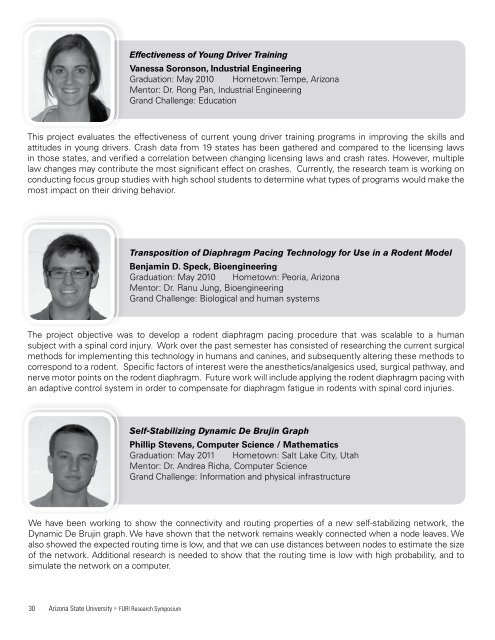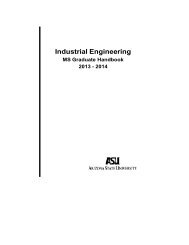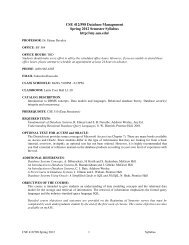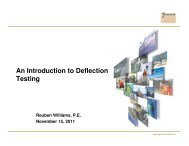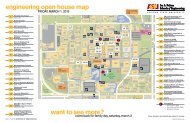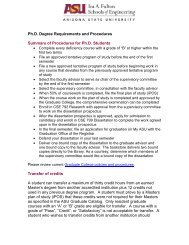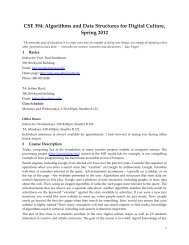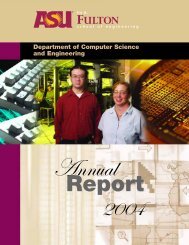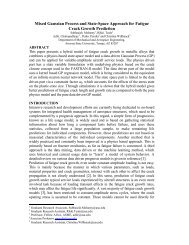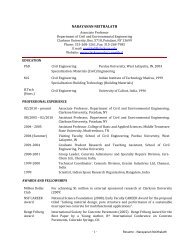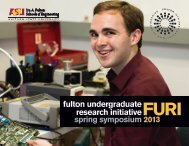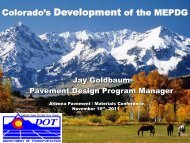Abstract Book - Ira A. Fulton Schools of Engineering - Arizona State ...
Abstract Book - Ira A. Fulton Schools of Engineering - Arizona State ...
Abstract Book - Ira A. Fulton Schools of Engineering - Arizona State ...
Create successful ePaper yourself
Turn your PDF publications into a flip-book with our unique Google optimized e-Paper software.
Effectiveness <strong>of</strong> Young Driver Training<br />
Vanessa Soronson, Industrial <strong>Engineering</strong><br />
Graduation: May 2010 Hometown: Tempe, <strong>Arizona</strong><br />
Mentor: Dr. Rong Pan, Industrial <strong>Engineering</strong><br />
Grand Challenge: Education<br />
This project evaluates the effectiveness <strong>of</strong> current young driver training programs in improving the skills and<br />
attitudes in young drivers. Crash data from 19 states has been gathered and compared to the licensing laws<br />
in those states, and verified a correlation between changing licensing laws and crash rates. However, multiple<br />
law changes may contribute the most significant effect on crashes. Currently, the research team is working on<br />
conducting focus group studies with high school students to determine what types <strong>of</strong> programs would make the<br />
most impact on their driving behavior.<br />
Transposition <strong>of</strong> Diaphragm Pacing Technology for Use in a Rodent Model<br />
Benjamin D. Speck, Bioengineering<br />
Graduation: May 2010 Hometown: Peoria, <strong>Arizona</strong><br />
Mentor: Dr. Ranu Jung, Bioengineering<br />
Grand Challenge: Biological and human systems<br />
The project objective was to develop a rodent diaphragm pacing procedure that was scalable to a human<br />
subject with a spinal cord injury. Work over the past semester has consisted <strong>of</strong> researching the current surgical<br />
methods for implementing this technology in humans and canines, and subsequently altering these methods to<br />
correspond to a rodent. Specific factors <strong>of</strong> interest were the anesthetics/analgesics used, surgical pathway, and<br />
nerve motor points on the rodent diaphragm. Future work will include applying the rodent diaphragm pacing with<br />
an adaptive control system in order to compensate for diaphragm fatigue in rodents with spinal cord injuries.<br />
Self-Stabilizing Dynamic De Brujin Graph<br />
Phillip Stevens, Computer Science / Mathematics<br />
Graduation: May 2011 Hometown: Salt Lake City, Utah<br />
Mentor: Dr. Andrea Richa, Computer Science<br />
Grand Challenge: Information and physical infrastructure<br />
We have been working to show the connectivity and routing properties <strong>of</strong> a new self-stabilizing network, the<br />
Dynamic De Brujin graph. We have shown that the network remains weakly connected when a node leaves. We<br />
also showed the expected routing time is low, and that we can use distances between nodes to estimate the size<br />
<strong>of</strong> the network. Additional research is needed to show that the routing time is low with high probability, and to<br />
simulate the network on a computer.<br />
30<br />
<strong>Arizona</strong> <strong>State</strong> University u FURI Research Symposium


